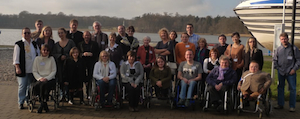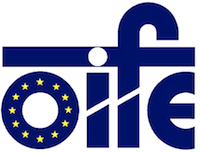Osteogenesis Imperfecta

Osteogenesis imperfecta (OI) is a group of rare genetic disorders that mainly affect the bones.
People with this condition have bones that break easily, often from mild trauma or with no apparent cause. Both Ute and her mother Ingeborg suffer from the mildest form of OI, type I. Both have been through multiple fractures, pain, hospitalisations. But 27 years separate the two women and their experience with OI is quite different.
Mother and daughter experience brittle bone disease
1936, Prague, Czech Republic. Little Ingeborg Wallentin is visibly in pain, she cries all the time. Because she has a femur fracture and a blue sclera (the part of the eye that is usually white) the prematurely born baby girl is diagnosed with Osteogenesis Imperfecta. She is only 10 days old, doctors say that she will not survive and her sad parents bring her home to die. If rare disease patients have always strived and fought for awareness, in 1936 there was no information at all and Ingeborg was lucky enough to have been correctly diagnosed even. Her parents knew one thing though – the syndrome was called “brittle bone disease” and that kind of says it all: the fewer fractures she had, the better she would do. Ingeborg is still alive. “My parents cared for me with love and I survived,” explains the now 74 year old lady.
1962, Germany. Ute is a little over 12 months old. She is beginning to walk and then comes her first fracture. After a series of traumas, she is diagnosed with the “brittle bone disease” and suddenly Ingeborg, her mother, realises that she has passed on her disease to her child. “I did not know that OI could be inherited, my parents were not affected and nobody informed us. I felt awfully guilty when Ute was diagnosed and I was very unhappy,” says Ingeborg. Ute has a more humorous way of remembering her diagnosis. “My mother was pregnant when I was diagnosed. Luckily, she did not know OI is a transmissible disease before, otherwise my brother and I would not exist!”
 Even though Ingeborg has since lived with the guilt of having passed OI to her daughter (her son does not have OI), Ute feels that she was “better protected” having a mother with the same disease as her. “My mother was always very careful and very over-protective. Every time I had a fracture, suffered from pain and hospitalisations, she felt responsible for my suffering and I always tried to make her feel better!”
Even though Ingeborg has since lived with the guilt of having passed OI to her daughter (her son does not have OI), Ute feels that she was “better protected” having a mother with the same disease as her. “My mother was always very careful and very over-protective. Every time I had a fracture, suffered from pain and hospitalisations, she felt responsible for my suffering and I always tried to make her feel better!”
School (minus sports class, of course) was business as usual for both Ute and her mum. But Ute recalls feeling quite lonely. “I had a very happy childhood with my family and friends and have wonderful memories. But in retrospect I know I felt quite lonely and sometimes even isolated because I was ‘different’. I could not do the same things as all the others, had to be careful and was protected by the special precautions put in place by my parents or other adults. My parents did everything possible to enable me to do as many normal activities as possible, but still I sometimes felt excluded from ‘normal life’.” Yet, Ute recalls a little compensation. “Well, I had the upper hand with my brother, I would manipulate him a lot and because I was ill, he could not get back at me! Maybe I was sometimes a horrible sister!”
 Ute Wallentin is now 47 and is as president of Osteogenesis Imperfecta Federation Europe (OIFE). She works part-time as a social worker with immigrants in the town of Bamberg. Her activities in the OI community were motivated by her feelings of loneliness in her childhood. “I was interested to find other OI people and to learn how they live and experience OI. We are the real OI specialists and can fortunately combine our efforts with those of many dedicated professionals.” OIFE has 23 members today, 17 from European countries and the others from Australia, Ecuador, Mexico, Peru, Georgia and the USA. “I do hope that the living conditions for people living with such a special and often unknown rare disorder will improve all around the globe and that we will be able to better support each other in future. I would be very hesitant to wish that OI or others similar disabilities shall be completely abolished. My goal is not to fight against, but to live a good life with my OI.”
Ute Wallentin is now 47 and is as president of Osteogenesis Imperfecta Federation Europe (OIFE). She works part-time as a social worker with immigrants in the town of Bamberg. Her activities in the OI community were motivated by her feelings of loneliness in her childhood. “I was interested to find other OI people and to learn how they live and experience OI. We are the real OI specialists and can fortunately combine our efforts with those of many dedicated professionals.” OIFE has 23 members today, 17 from European countries and the others from Australia, Ecuador, Mexico, Peru, Georgia and the USA. “I do hope that the living conditions for people living with such a special and often unknown rare disorder will improve all around the globe and that we will be able to better support each other in future. I would be very hesitant to wish that OI or others similar disabilities shall be completely abolished. My goal is not to fight against, but to live a good life with my OI.”
Ingeborg believes that Osteogenesis Imperfecta has not much affected her adult life: she worked, got married, gave birth to two children, found help around her whenever necessary, and she has family and friends who cherish her. After all, perhaps Ingeborg provides the example of what her daughter wishes for every rare disease patient: having a good life.
Watch a video interview with Ute Wallentin:
This article was first published in the July 2010 issue of the EURORDIS newsletter
Author: Nathacha Appanah
Photo credits: © Ute Wallentin & OIFE
